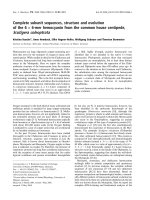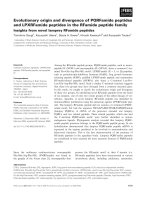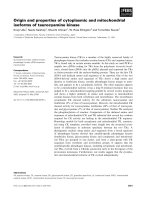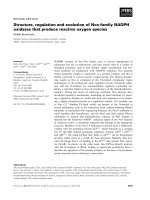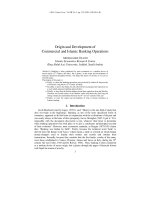The Origin and Evolution of the Bra - Kristina Woo Kyung Shin (2009)
Bạn đang xem bản rút gọn của tài liệu. Xem và tải ngay bản đầy đủ của tài liệu tại đây (19.73 MB, 352 trang )
Citation: Shin, Woo Kyung (2009) The origins and evolution of the bra. Doctoral thesis,
Northumbria University.
This version was downloaded from Northumbria Research Link:
/>Northumbria University has developed Northumbria Research Link (NRL) to enable
users to access the University’s research output. Copyright © and moral rights for items
on NRL are retained by the individual author(s) and/or other copyright owners. Single
copies of full items can be reproduced, displayed or performed, and given to third parties
in any format or medium for personal research or study, educational, or not-for-profit
purposes without prior permission or charge, provided the authors, title and full
bibliographic details are given, as well as a hyperlink and/or URL to the original
metadata page. The content must not be changed in any way. Full items must not be sold
commercially in any format or medium without formal permission of the copyright
holder. The full policy is available online: />
THE ORIGINS AND EVOLUTION OF
THE BRA
KRISTINA WOO KYUNG SHIN
PhD
2009
THE ORIGINS AND EVOLUTION OF
THE BRA
Kristina Woo Kyung Shin, M.A.
A thesis submitted in partial fulfilment
of the requirements of the
University of Northumbria at Newcastle
for the degree of
Doctor of Philosophy
Research undertaken in the School of Design
January 2009
1
ABSTRACT
This thesis marks the first biography of the evolution of the bra from a designer and
patternmaker’s perspective. Although the bra has a very long history, it only became
a truly iconic garment in the latter half of the Twentieth Century. To some extent this
transformation was driven by rapid social and economic changes, but the evolution
of this highly technical garment is also inextricably linked to developments in
technology which have led to improvements in materials, design and manufacture.
Initially these developments were related to designing a three-dimensional product
from a two-dimensional flat patternmaking process, but more recently the advent of
the moulded bra has offered opportunities to create a seamless three-dimensional
garment without the need to construct a flat pattern, and this has enabled both
increased design possibilities and raised the prospect of a better fitting product.
Through an investigation of the origins of underwear in general, and the bra in
particular, this thesis reviews secondary source historical data to chart major changes
in design, patternmaking, and technology from the first recorded uses of underwear
to the current challenges facing bra designers and patternmakers in an increasingly
globalised industry. This historical review culminates in the identification of two
distinctly diverging trends in current bra design and manufacture, both of which face
significant challenges in terms of training new designers and producing better sizing
and fitting protocols. The two primary source studies which emanate from this
historical review contribute new knowledge to each of these diverging directions in
bra design.
The first study provides an entirely new approach to the teaching, and subsequent
current commercial practice of flat patternmaking for what many regard as the
‘traditional’ cut-and-sewn variety of bra. This study culminates in a new way of
producing, learning and teaching the art of flat patternmaking, enabling underwear
design graduates to leave university with the core skills they need to survive in a fast
moving global industry. The second major study investigates the salient challenge of
providing an excellent fit for both major types of bra across globally diverse and
perhaps ethnically different body types. Consequently, it employs cutting-edge three-
dimensional body scanning technology to demonstrate how the design, sizing, and
2
fitting of both cut-and-sewn and moulded varieties of garment might be significantly
improved in the future. Both primary source data studies therefore stand at the
beginning of the future evolution of the most technically complex garment in human
history, the not so humble bra.
3
CONTENTS
ABSTRACT………………………………………………… …………………… 2
LIST OF CONTENTS……………………………………………… …………….4
LIST OF FIGURES……………………………………………………… ………16
LIST OF TABLES…………………………………………………………………21
ACKNOWLEDGMENTS ……………………………………………………… 23
DECLARATION………………………………………………………………… 24
CHAPTER 1: THE CONTINUING BIOGRAPHY OF THE BRA………… 25
1.1 A Biography of the Bra……………………………………………………… 25
1.2 The Concept of Underwear……………………………………………………26
1.3 The Evolution of Underwear………………………………………………….27
1.4 The Birth of the Modern Bra………………………………………………….28
1.5 Conflict and Divergence……………………………………………………….29
1.6 Trends in Modern Bra Technology………………………………………… 30
1.7 The History of Bra Patternmaking………………………………………… 30
1.8 Flat Patternmaking and a New Approach……………………………………31
1.9 Bra sizing: Current Inadequacies and Future Possibilities…………………32
1.10 Looking Backwards and Moving Forwards……………………………… 33
CHAPTER 2: THE EARLY EVOLUTION OF UNDERWEAR FROM
600,000BC TO 1000AD……………………………………………………………35
2.1 Introduction: The Concept of Underwear……………………………………35
2.1.1 The Origins of the Concept of Underwear……………………………… 35
2.1.2 Underwear as Utilitarian Garments……………………………………….36
2.1.3 Summary………………………………………………………………… 37
2.2 The Beginnings of Clothing Technology for Prehistoric Costume….………37
2.2.1 Background……………………………………………………………… 37
2.2.2 Utilitarian ‘Fashion’……………………………………………………….38
2.2.3 The Impact of Early Fibre Science and Technology………………… ….40
2.2.3.1 Early Evidence of Spinning Technology……………… ………………40
2.2.3.2 Spinning and Weaving Technology…………………….……………… 41
2.2.3.3 Silk and Cotton…………………………………………………………… 44
4
2.3 Prehistoric Clothing from 3,500BC to 400AD…………………………….…44
2.3.1 The Ancient East………………………………………………………….45
2.3.2 The Sumer (Valleys and Plains)……………………………………… 45
2.3.3 Babylonia and Assyria (Valleys and Plains)………………………… ….47
2.3.4 Syria and Phoenicia (Eastern Mediterranean and Black Sea)…………….47
2.3.5 Anatolia, Armenia, the Caucasus, Persia, Afghanistan and Baluchistan
(mountain countries)…………………………………………………………….48
2.3.6 Steppe Nomads (Irano-Indian Regions) 49
2.3.7 Mycenae, Crete and Cyprus………………………………………….……49
2.4 Costume from Africa/Egypt…………………………………………… …….51
2.5 Central Mediterranean 52
2.5.1 Greece 52
2.5.2 Rome (510BC – 330AD) 53
2.5.3 Byzantine: The Greek Speaking Roman Empire (330 to 1025AD)…… 55
2.6 Europe…………………………………………………………………… ……55
2.7 Summary……………………………………………………………….………58
2.7.1 The Early Evolution of Underwear……………………………….….……58
2.7.2 The Concept of Underwear for ‘Fashion’……………………… …….….60
2.7.3 The Utilitarian Possibility……………………………………………… 60
CHAPTER 3: THE EVOLUTION OF UNDERWEAR FROM 1001AD TO
THE EARLY 1900S……………………………………………………………… 63
3.1 Introduction: Outerwear Fashion and Underwear Development.………….63
3.2 The Medieval Period /Middle Ages (1001AD -1484AD)…………… …… 63
3.2.1 Characteristics of the Medieval Female Attire …………… 65
3.2.1.1 The Chemise…………… ………………… 65
3.2.2 Characteristics of the Medieval Male Attire ………………………… …65
3.2.2.1 The Shirt and Braies …………………………………………………….65
3.3 The Tudor Period (1485-1603) ……………………………………………….66
3.3.1 Characteristics of the Tudor Period Female Attire……………………… 67
3.3.1.1 The Chemise… 67
3.3.1.2 The Corset………………………………………………………………… 68
3.3.1.3 The Waistcoat …………………………………………………… ………68
3.3.1.4 The Petticoat ………………………………………………………………69
5
3.3.1.5 The Farthingale…………………………………………………… …… 69
3.3.1.6 The Bum roll……………………………………………………………… 69
3.3.1.7 The Drawers……………………………………… ………………………69
3.3.2 Characteristics of the Tudor Period Male Attire……………………… 70
3.3.2.1 The Shirt…………………………………………………………………….70
3.3.2.2 The Waistcoat………………………………………………… ………….70
3.3.2.3 The Corset………………………………………………………………… 70
3.4 The Seventeenth Century………………………………………… …………70
3.4.1 Characteristics of the 17
th
Century Female Attire………………… … 72
3.4.1.1 The Chemise…………………………………………………… …………72
3.4.1.2 The Corset………………………………………………………………… 72
3.4.1.3 The Farthingale……………………………………………………………73
3.4.1.4 The Bustle………………………………………………………………… 73
3.4.1.5 The Waistcoat………………………………………………………………73
3.4.1.6 The Drawers……………………………………………….……………….73
3.4.2 Characteristics of the 17
th
Century Male Attire …………… ………….73
3.4.2.1 The Shirt…………………………………………….… ………………… 73
3.4.2.2 The Drawers……………………………………………………………… 74
3.5 The Eighteenth Century……………………………………….………………74
3.5.1 Characteristics of the 18
th
Century Female Attire……………………… 76
3.5.1.1 The Chemise……………………………………………………………… 76
3.5.1.2 The Habit-shirt……………………………………………….…………….76
3.5.1.3 The Corset…………………………………………….…………………….77
3.5.1.4 The Petticoat……………………………………………………………….77
3.5.1.5 The Hoop…………………………………………………….……………. 78
3.5.1.6 The Bustle…………………………………………………… ……………78
3.5.1.7 The False bosom………………………………………… ……………….78
3.5.2 Characteristics of the 18
th
Century Male Attire…………………….….….79
3.5.2.1 The Shirt…………………………………………………………………….79
3.5.2.2 The Drawers……………………………………………… ………………79
3.5.2.3 The Corset……………………………………………………………… 80
3.6 The Nineteenth Century……………………………………………… …… 80
3.6.1 The Influence of Technological Developments…………………… …….80
3.6.2 Characteristics of the 19
th
Century Female Attire……………………… 81
6
3.6.2.1 The Chemise……………………………………………….……………….81
3.6.2.2 The Drawers…………………………………………… … ……82
3.6.2.3 The Pantaloons and Pantalettes………………………… ….……….82
3.6.2.4 The Petticoat……………………………………… …………….83
3.6.2.5 The Crinoline…………………………………………………… … 83
3.6.2.6 The Bustle…………………………………………………… …84
3.6.2.7 The Crinolette and Tournure…………………………… ………85
3.6.2.8 The Corset…………………………………………… …………85
3.6.2.9 The Corset cover or Camisole…………………… …………….86
3.6.2.10 The Bust Bodice…………………………………… ………….87
3.6.2.11 The Combinations…………………………………… …………….87
3.6.2.12 The False bosom………………………………………… ……88
3.6.3 Characteristics of the 19
th
Century Male Attire……………………… 89
3.6.3.1 The Shirt……………………………………………… ……….89
3.6.3.2 The Drawers……………………………………………… ……… 89
3.6.3.3 The Corset……………………………………… …………… 89
3.7 The Early Twentieth Century/Turn of the Century…………… …… 90
3.7.1 Characteristics of the Early 20
th
Century Female Attire……… …… 91
3.7.1.1 The Chemise………………………………………… ……… 91
3.7.1.2 The Corset……………………………………………… …….91
3.7.1.3 The Petticoat………………………………………… ……….92
3.7.1.4 The Drawers or Knickers……………………… …………….92
3.7.1.5 The Combination……………………………… …………….93
3.7.1.6 The Camisole…………………………………………… ……93
3.7.1.7 The Brassiere……………………………………… …………93
3.7.1.8 The Bust bodice………………………………… ……………94
3.7.1.9 The False bosom…………………………………… ……… 94
3.7.2 Characteristics of the Early 20
th
Century Male Attire……… ….95
3.7.2.1 The Shirt……………………………… …………………… 95
3.7.2.2 The Combination……………………… …………………….95
3.8 Summary……………………………………………… …………………96
CHAPTER 4: THE EVOLUTION OF THE BRASSIERE FROM THE
EARLY 1900S TO THE LATE 1950S.………………………………………… 99
7
4.1 The Origins of the Modern Brassiere…………………………….………… 99
4.2 The Mid-19
th
Century to 1910: The Era of the Corset and the Bust-Bodice
100
4.2.1 The Corset as the Predecessor of the Modern Bra…………… … 100
4.2.2 The ‘Bust Bodice’ as the Predecessor of the Modern Bra ………101
4.2.3 Summary……………………………………………………… …….102
4.3 The late 19
th
Century and the First Modern Bra……………… ……… 103
4.4 Developments from the 1910s ……………………………………… ….104
4.5 Developments from the 1920s………………………………………… … 105
4.6 Developments from the 1930s………………………………………… … 106
4.6.1 Three Further Significant Developments………………………… …107
4.6.1.1 The Advent of the Bra Sizing System………………………… 107
4.6.1.2 The Establishment of a Complete Conventional Bra Design… 108
4.6.1.3 The Development of New Materials, in Particular Lastex and
Nylon 108
4.7 Developments from the 1940s…………………………………………… …109
4.7.1 Post-war Developments……………… ………………………… ….110
4.7.2 The Push-up Bra………………………………………………… … 111
4.7.3 The Advent of the Bikini and Nylon……………………………… 112
4.7.4 Post-war Market Diversification…………………………………… 113
4.8 Developments from the 1950s: Details and More Details…………….……113
4.8.1 Shape, Cup-padding and Wire………………………………… …… 114
4.8.2 Changing Shapes, Colours and Fibres…………………………… … 115
4.8.3 Whirlpools, Circles and the Beginnings of the Moulded Bra………… 116
4.9 Summary……………………………………………………………….…… 116
CHAPTER 5: THE MODERN HISTORY OF THE BRA…………………….119
5.1 Introduction………………………………………………………………… 119
5.2 The Fall and Rise of the Bra in the 1960s………………………… ………119
5.3 The Unisex, Multi-trend in the 1970s……………………………………… 122
5.3.1 The Establishment of Music as an Influence on Fashion………… … 123
5.3.2 The Growth of Underwear for the Health Conscious …………… … 123
5.3.3 Computer-aided Design and Outsourcing……………………… ……124
5.4 The Rise of Power-dressing and New Romanticism in the 1980s………….124
8
5.4.1 The Rise of Power-dressing 124
5.4.2 The Rise of New Romanticism……………………………… …………125
5.5 Achieving Individuality in the 1990s ……………………………………… 126
5.5.1 Underwear Evolves into Outerwear……………………… ………….126
5.5.2 The Further Development of the Bra…………………… ……………127
5.5.3 The Rise and Rise of the Sports Bra……………………… ………….128
5.5.4 Innovations in Moulding Technology…………………… ………… 129
5.6 The New Millennium…………………………………………… ………….130
5.6.1 Outerwear Trends……………………………………………… ……130
5.6.2 Underwear Trends…………………………………………… ………131
5.6.2.1 Smart Bras………………………………………………… … 132
5.6.2.1.1 The Bioform bra (2000)………………………… ………… 132
5.6.2.1.2 The Brava bra (2001)…………………………… ………….132
5.6.2.1.3 The NuMetrex heart sensing sports bra (2005) ……… 132
5.6.2.1.4 The Ipex bra (2006)…………………………………… … 132
5.6.2.1.5 The ITEC bra (2006)……………………… ……… 133
5.6.2.1.6 The Cleavacious bra (2006)…………………… ……….133
5.6.2.1.7 A cancer screening bra (2007)………………… ………… 133
5.6.3 The Rise and Fall of the Push-up Bra……………………… ………133
5.6.4 The Rise and Rise of the Sports Bra……………………… ……… 134
5.6.5 The Big Size Bra………………………………………… ………… 135
5.6.6 The Nursing Bra………………………………………… ………… 136
5.6.7 Further Innovations: Stick-on Bras……………………………… ….137
5.6.8 Iconic and Newsworthy Bras from the New Millennium……… ……137
5.6.9 The Bra for Young Girls………………………………………… … 139
5.6.10 A More Positive Note: Breast Cancer………………………… …….139
5.6.11 Business Development in the New Millennium……………… …… 140
5.6.12 Material Technology and Innovation………………………… …….142
5.7 Conclusion………………………………………………………………….…143
CHAPTER 6: TRENDS IN MODERN BRA TECHNOLOGY AND
MATERIALS…………………………………………………………………… 145
6.1 Introduction…………………………………………………… …………….145
6.2 Moulding Technology……………………………………………………… 145
9
6.2.1 A History of Fabric Moulding Technology………………………….… 146
6.2.2 Modern Moulding Equipment ……………………………………….….149
6.2.2.1 Types of Mould Heads………………………………………… … 150
6.2.2.2 The Moulding Problem of Yellowing…………………… ………151
6.2.2.3 The New Generation of Moulding Machines…………… …….152
6.3 Modern Moulding Materials……………………………………… ………153
6.3.1 Polyurethane (PU) Foam ……………………………………… ……153
6.3.2 Fibrefill………………………………………………………… ………154
6.4 Moulding vs. Cutting & Sewing …………………………………….………154
6.5 Bonding and Lamination Technology ………………………………………155
6.5.1 Adhesives……………………………………………………… ……….155
6.5.2 Advanced Bonding Technology - Sewfree®…………………….………156
6.5.3 Bonding Machines……………………………………………… …… 157
6.5.3.1 The Edge Bending Machine…………………………………… … 158
6.5.3.2 Lycra® Tape …………………………………………………… ……158
6.5.3.3 Applications of Bonding Technology……………………… ……… 159
6.6 Ultrasonic Sewing Technology……………………………………….………159
6.6.1 Ultrasonic Welding for Textiles…………………………………………160
6.6.2 Non-stitching Bonding Methods…………………………………………162
6.6.3 Parameters for Ultrasonic Welding …………………………………… 162
6.6.4 Ultrasonic Welding for Bra Construction………………………… 163
6.7 Seamless knitting Technology…………………………………… ……165
6.7.1 The Origins of Seamless Knitting Technology……………… …… 165
6.7.2 Revolutions in Seamless Knitting Technology……………… …… 165
6.7.3 Knitted Bras…………………………………………………… ……….166
6.7.4 A Summary of the Advantages of Seamless Garment Production ….168
6.7.5 Yarns for Seamless Knitting…………………………………… ………169
6.8 Material Trends………………………………………………………………170
6.8.1 Eco Friendly Materials………………………………………….……….170
6.8.1.1 Bamboo…………………………………………………………… ….170
6.8.1.2 Ingeo™……………………………………………………………….……171
6.8.1.3 Lyocell/Tencel®………………………………………………… …… 171
6.8.1.4 Modal………………………………………………………….………… 172
6.8.1.5 Organic cotton………………………………………………… ….172
10
6.8.1.6 SeaCell®…………………………………………………… …… 173
6.8.1.7 Soy……………………………………………………… ……… 173
6.8.2 Smart Materials…………………………………………… ………….173
6.8.2.1 Shape Memory Foam…………………………………… ……174
6.8.2.2 Shape Memory Wire…………………………………… …….174
6.9 Conclusion……………………………………………………………… ….175
CHAPTER 7: THE HISTORY OF BRA PATTERNMAKING………………177
7.1 Introduction………………………………………………………………… 177
7.2 The Mid 19
th
Century to 1899-Early Foundations for the Bra……………177
7.2.1 The Cross back or ‘X’-shape Design…………………………………….178
7.2.2 Bra Terminology and Construction Methods………………… … 179
7.3 The 1900s…………………………………………………………… ……….181
7.3.1 Cup Construction Methods……………………………………… …….181
7.3.2 Terminology…………………………………………………….……….182
7.4 The 1910s………………………………………………………………….… 183
7.4.1 An Early Form of the Underwired Bra………………………… …… 184
7.4.2 The Adjustable Centre Piece…………………………………… …… 185
7.4.3 Crossover Design: The X-factor……………………………….……… 186
7.5 The 1920s………………………………………………………………….… 186
7.5.1 Silhouette and Construction Methods……………………………… ….187
7.5.2 Breast Separation and the Centre Piece or Gore…………………… 190
7.5.3 Crossover Design: The X-factor…………………………………… … 192
7.6 The 1930s…………………………………………………………………… 192
7.6.1 Crossover Design: Diagonal Support………………………… ……….194
7.7 The 1940s…………………………………………………………………… 196
7.7.1 The Birth of the Long-line Brassiere…………………………… …….196
7.7.2 The Material Revolution and its Impact on Bra design……… ………197
7.7.3 Breast Separation ………………………………………………….…….198
7.7.4 Wire Development and its Effect on Bra Patternmaking………… ….199
7.8 The 1950s……………………………………………………………… …….199
7.8.1 The Conical Cup with Spiral Stitching and the Advent of an Intermediate
Layer……………………………………………………………… 200
7.9 The 1960s…………………………………………………………… ……….202
11
7.9.1 The Frame Concept or Neckline and Gore Integration………… …… 202
7.10 The 1970s…………………………………………………………………….204
7.10.1 The Breast Supporting Band of the 1970s……………………… …….204
7.10.2 Adaptability, Flexibility, and Adjustability…………………… ….205
7.11 The 1980s…………………………………………………………… …… 206
7.11.1 Sports Bras from the 1980s…………………………………… …… 206
7.11.2 Compression Bras vs. Encapsulation Bras…………………………… 207
7.11.3 Wide and Crossed Shoulder Straps…………………………… ……209
7.12 The 1990s…………………………………………………………… …… 209
7.12.1 Push-up Bras and Breast Enhancing Bras……………………… ….209
7.13 The New Millennium…………………………………………….………….211
7.13.1 The Seamless or One Piece Bra……………………………… …… 212
7.14 Summary ……………………………………………………………………213
CHAPTER 8: PATTERNMAKING FOR THE UNDERWIRED BRA: NEW
DIRECTIONS …… 215
8.1 Introduction………………………………………………………………… 215
8.2 Context…………………………………………………………………….… 215
8.3 The History of Pattern Cutting and Evolution of the Basic Block……… 216
8.4 The Four Different Patternmaking Methods………… ………………… 220
8.4.1 Draping…………………………………………………………… ……220
8.4.2 Pattern Drafting…………………………………………………… ….221
8.4.3 Flat Patternmaking ……………………………………………… ……221
8.4.4 Knock-off ……………………………………………… …………… 222
8.5 The Development of the Intermediate Block………………………….…….222
8.6 Review of the Bra Patternmaking Approach…………………………….…224
8.7 The Underwired Bra Patternmaking Process…………………………… 226
8.7.1 ‘Ideal’ Body Measurements for 75B and Direct Drafting of Full Cup Bra
Body Measurements………………………………………………… 226
8.7.2 Band Drafting………………………………………………………… 228
8.7.2.1 Finding the Centre of Wire …………………………………… …228
8.7.2.2 Marking the Guide Lines……………………………………… 229
8.7.2.3 Tracing Wire and Opening the Wire………………………… 229
8.7.2.4 Allowance for Wire and Wire Play………………………… ….229
12
8.7.2.5 Mid-point of Cradle Height……………………………… ……229
8.7.2.6 Wing Drafting……………………………………………… …230
8.7.2.7 Finishing the Band Drafting……………………………… … 230
8.7.2.8 Measuring Joining Seam/Preparation for Cup Drafting…… 230
8.8 Cup Drafting…………………………………………………………… …231
8.8.1 Lower Cup.………………………………………………… …… 231
8.8.1.1 Guide Lines………………………………………………… 231
8.8.1.2 Upper Curve Lines of Lower Cup…………….…………… 231
8.8.1.3 Lower Curve Lines of Lower Cup………………….……… 231
8.8.1.4 Splitting the Lower Cup…….……………………………… 231
8.8.2 Upper Cup………………………………………………… …… 232
8.8.2.1 Joining Seam Length…………………………………… …232
8.8.2.2 Upper Cup Height………………………………………… 232
8.8.2.3 Shoulder Strap…………………………………………… 232
8.9 The Impact of the Underwire on the Patternmaking Process… … 233
8.10 A New Method: Shin’s Bra Pattern……………………………… 234
8.10.1 Basic Block: Lower Cup Pattern……………………….… …234
8.10.2 Development of the Intermediate Block …………… …………236
8.11 Pattern Manipulation: Industry Drafting Method vs. Shin’s Method 236
8.11.1 Pattern Manipulation Using the Intermediate Block………… 238
8.12 Method………………………………………………………… ……….239
8.12.1 Patternmaking……………………………………………… ……239
8.12.2 Cutting…………………………………………………… ………240
8.12.3 Sewing…………………………………………………… ………240
8.12.4 Sewing Machines Used…………………….…………………… 240
8.12.5 Fitting Result: Industry Direct Drafting vs. Shin’s Method… 241
8.13 Conclusion…………………………………………………………… …242
CHAPTER 9: THE FAILURE OF BRA SIZING SYSTEMS AND THE
POTENTIAL FOR 3D BODY SCANNING TECHNOLOGY:
A QUANTITATIVE STUDY IN ETHNIC DIVERSITY…… ………… 245
9.1 Introduction………………………………………………………………… 245
9.2 Bra Sizing Systems and Breast Measurement Protocols……………… …246
9.2.1 Bra Sizing and Labelling: Current Industry Practice……………… 246
13
9.2.2 Bra sizing for Plastic Surgery……………………………………… …247
9.2.3 Breast Measurement Protocols in the Western Context………… ….248
9.2.4 Breast measurement Protocols in an Asian Context……………… 250
9.3 Anthropometry and its Tools………………………… ……………………253
9.3.1 Anthropometry for Clothing Design……………… ……………………253
9.3.2 Anthropometric Data Collection Tools…………… ………………254
9.3.2.1 Manual Measuring Tools……………………… …………… 254
9.3.2.2 The Introduction of the 3D Body Scanner……………… … 255
9.4 Method………………………………………………………………… … 258
9.4.1 Design………………………………………………………… …… 258
9.4.2 Participants……………………………………………………… ….258
9.4.3 Apparatus……………………………………………………… ……259
9.4.4 Procedure…………………………………………………… ………260
9.4.5 Variables……………………………………………………… …… 261
9.5 Results.…………………………………………………………… ……… 264
9.5.1 Analysis of All Data …………………………………………… … 264
9.5.2 Analysis of All Data by Four Somatotypes……………………… … 266
9.5.3 Analysis of All Data for Bra Sizes US 34A and 34B…………… … 269
9.6 Discussion………………………………………………………… …………271
9.6.1 Bust Point to Bust Point and Sternum Width ……………… …… 271
9.6.2 Bust Girth, Height, and Underbust Height…………………… ……273
9.6.3 Full Bust Depth……………………………………………… ……….275
9.7 Conclusion…………………………………………………………… …….275
CHAPTER 10: CONCLUSION…………………………………………………279
10.1 Introduction…………………………………………………………….……279
10.2 Origins of the Species ………………………………………………………280
10.3 The Evolution of Underwear and the Birth of the Bra………………… 281
10.4 The Modern History of the Bra from the 1960s…………………… … 284
10.5 Technological and Product Bifurcation…………………………… ……. 286
10.6 Flat Patterns and Moulded Technology…………………………… ……288
10.7 Summary……………………………………………………………….……290
10.7.1 Culture, Politics, and Power………………………………………… 290
10.7.2 Technological Developments and Challenges…………………… … 292
14
10.7.3 Future Directions………………………………………………… … 294
10.8 Conclusion………………………………………………………… ….……295
REFERENCES………………………………………………………… ….……297
APPENDICES
List of Appendices Contents A1
Appendix A: Consent Form for Body Scanning …… ……………… … A2
Appendix B: Analysis of All Data.……… ………………………….… …… A4
Appendix C: Analysis of All Data Relevant to Bra Size …………….… …… A5
Appendix D: Analysis of Small Mesomorphs ………….… ……… A6
Appendix E: Analysis of Endomorphs ………….… ……… A7
Appendix F: Analysis of Ectomorphs ………….… ……… A8
Appendix G: Analysis of Large Mesomorphs ………….… ……… A9
Appendix H: Body Measurements of Asian Participants………………….… A10
Appendix I: Body Measurements of Caucasian Participants………… … A12
Appendix J: Figure 12 Timelines from 600,000BC to 1000AD……………… A14
15
LIST OF FIGURES
Figure 1: The front and back view of the ‘Venus of Lespugue’ (Source: Musée de
l’Homme, 2006)…………………………………………………………… ………41
Figure 2: Neolithic Egyptian dish showing a ground-loom (Source: Petrie Museum,
University College London: UC9547, 2006)……………………………………… 42
Figure 3: Reconstruction of Ötzi with clothing and equipment (Source: South Tyrol
Museum of Archaeology, 2006)……………………………………….……………42
Figure 4: Reconstructed female attire from the Bronze Age (Source: The National
Museum of Denmark, 2006 ) …………………………………………………….…43
Figure 5: Map of Ancient Near East (Source: Boucher, 1996)……… ….…… 45
Figure 6: Sumerian terracotta from 3000BC (Source: Louvre, 2006)……… … 46
Figure 7: Ebihil, superintendent of the Ishtar Temple at Mari from 2400BC (a) and
Statuette de Femme Vêtue d'un Kaunakès, Appelée ‘Princesse De Bactriane’ (b)
(Source: Louvre, 2006)………………………………………………………… …47
Figure 8: Snake goddess from the late Minoan period from 1800BC (Source:
Heraklion Museum, 2006)……………………………………………………….….50
Figure 9: Loincloth worn by Egyptians. Source: Bruhn and Tilke, 1955……….… 51
Figure 10: Mosaic image from the Villa Romana del Casale, Piassa Armerina, in
Sicily. (Source: Roux, 2006)……………………………………………………… 54
Figure 11: Mosaic images of a Roman woman wearing underwear from Villa
Romana del Casale in Sicily (Source: Roux, 2006)……………………………… 55
Figure 12: Timelines from 600,000BC to 1000AD…………………………………57
Figure 13: Artefacts depicting garments resembling modern underwear……… 59
Figure 14: Medieval attire in England (Source: Bruhn & Tilke, 1955)……… 64
Figure 15: Medieval women’s chemise (Source: Thursfield, 2001) 65
Figure 16: Medieval braies and shirt (Source: Thursfield, 2001) 66
Figure 17: Spanish fashion in France from 1575 to 1590 (Source: Bruhn & Tilke,
1955) 67
Figure 18: Late 16
th
Century Italian shirt, camicia and drawers (Source: Cunnington
and Cunnington, 1992) 68
Figure 19: Mid 17
th
Century mode (Source: Gorsline, 1978) 71
Figure 20: Linen chemise from 1700 or earlier (Source: Cunnington and Cunnington,
1992) 72
16
Figure 21: Shirts and drawers from the 17
th
Century (Source: Cunnington and
Cunnington, 1992) 74
Figure 22: The 18
th
Century outfits in France (Source: Bruhn & Tilke, 1955) 75
Figure 23: Habit-shirt from the18
th
Century (Source: Cunnington and Cunnington,
1992) 76
Figure 24: Chemise and corset from the 18
th
Century (Source: Ewing, 1971) 77
Figure 25: Cartoons of false bosoms from the late 17
th
Century (Source:
Hawthorne, 1992) 78
Figure 26: Men’s shirt from France, 1750 (Source: Cunnington and Cunnington,
1992) 79
Figure 27: Early 19
th
Century mode in England (Source: Bruhn & Tilke, 1955) 81
Figure 28: Chemise from 1800 (a) and 1866 (b) (Source: Ewing, 1971) 82
Figure 29: Drawers from 1825-1830 (a) and 1860 (b) (Source: Ewing, 1971) 82
Figure 30: Princess petticoat from 1820 (Source: Cunnington and Cunningtion,
1992) 83
Figure 31: Crinolines from the 19
th
Century (Source: Cunnington and Cunnington,
1992) 84
Figure 32: Bustles from the early 19
th
Century (a), from 1875(b), from 1885(c) and
from 1888(d) (Source: (a) & (d)-Cunnington and Cunnington, 1992 and (b) & (c)-
Ewing, 1971) 84
Figure 33: Crinolettes and tournures from an advertisement for Skinner’s in 1885
(Source: Carter, 1992) 85
Figure 34: (a) Corset from 1879 and (b) Jaeger corset from 1886 (Source:
Cunnington and Cunnington, 1992) 86
Figure 35: Corset cover from the 1880s (Source: Ewing, 1971) 86
Figure 36: Bust bodices from 1890 (Source: Ewing, 1971) 87
Figure 37: Jaeger combination from 1886 (Source: Ewing, 1971) 88
Figure 38: False bosom from the 1800s (Source: Hawthorne, 1992) 88
Figure 39: Men’s corsets from the mid-19
th
Century (Source: Carter, 1992) 90
Figure 40: The early 20
th
Century mode (Source: Gorsline, 1978) 91
Figure 41: Corset from the early 20
th
Century (Source: Ewing, 1971) 92
Figure 42: Flannel drawers from 1909 (a) and open knickers from 1912 (b)
(Source: Ewing, 1971) 92
17
Figure 43: Silk combination from 1905 (a), cotton combination from 1916(b), close
cami-knickers from 1920 (c) and silk cami-knickers from 1934 (d)
(Source: Ewing, 1971) 93
Figure 44: Camisole from 1918 (Source: Cunnington and Cunnington, 1992) 93
Figure 45: Bust bodice from the 20
th
Century (Source: Ewing, 1971) 94
Figure 46: False bosom of the early 1900s (Source: Hawthorne, 1992) 94
Figure 47: Male combinations/union suits by Jaeger: (a) & (b) from 1914-1915
and (c) from 1936-7 (Source: Cunnington and Cunnington, 1992) 95
Figure 48: Breast supporter by Luman Chapman (Source: Chapman, 1863) 100
Figure 49: Bust bodice 1915 (Source: Leicestershire County Council, 2006) 102
Figure 50: Breast supporter patented by Marie Tucek (Source: Tucek, 1893) 103
Figure 51: Brassiere by Mary Phelps Jacob (Source: Jacob, 1914) 104
Figure 52: Underwire and overwire figures from the patent applications
(Source: Glick, 1949b and Gluckin, 1949b) 113
Figure 53: Moulding machine with double bullet mould (Source: Liu, 2007a) 150
Figure 54: Rigid mould head vs. elastic mould head 151
Figure 55: Macpi 365 (Source: Macpi, 2008) 152
Figure 56: Flat bed fusing machine (a) and edge bending machine (b) (Source:
Macpi, 2008) 157
Figure 57: Adhesive tape and releasing tape on the edge bending machine (Source:
Macpi, 2008) 159
Figure 58: Ultrasonic welding machine (Source: Rinco, 2008) 161
Figure 59: Governing factors of ultrasonic welding strength (Source: Shi and Little,
2000) 163
Figure 60: Shoulder strap slide (a), shoulder strap at platform (b), ring (c) and eye
tape (d) (Source: Walther, 2005) 164
Figure 61: X-shape of shoulder straps on the back from the US patent
application 178
Figure 62: Breast supporters in the 1900s 181
Figure 63: Breast supporter, an early form of the underwire bra (Source: Gabeau,
1911) 184
Figure 64: The brassieres for flappers in the 1920s 187
Figure 65: Dart manipulations, the advent of the centre dart 188
Figure 66: Early soft bra with pattern pieces (Source: Negri, 1924) 189
18
Figure 67: Two influential 1920s brassiere patterns 190
Figure 68: Slings in the 1920s 191
Figure 69: Four different types of slings from the 1930s 193
Figure70: Examples of the 1930s crossover bras 195
Figure 71: Examples of the 1950s bras with spiral stitching on a conical cup 200
Figure 72: Examples of the 1960s ‘framed’ bras 202
Figure 73: Examples of breast supporting bands from the 1970s 205
Figure 74: Two types of sports bra 208
Figure 75: A diagrammatic example of a push-up bra 211
Figure 76: A seamless brassiere (Source: Huang, 2002) 212
Figure 77: Use of basic bodice block in US patent no. 1,944 (Tentler, 1841)
(Source: Kidwell, 1979) 219
Figure 78: Bra block development from basic bodice block (Source: Hagger,
2004) 225
Figure 79: Ideal breast measurements for 75B 227
Figure 80: Underwired bra band drafting 228
Figure 81: Cup drafting 230
Figure 82: Complete pattern pieces with seam allowance, matching notches and
pattern information 233
Figure 83: Design variation of lower centre wire bra 233
Figure 84: Example of off-proportioned upper cup pattern (a) and (b) 234
Figure 85: U-shape back band pattern with a cup guide pattern 235
Figure 86: Development of intermediate block (step 1) 236
Figure 87: Development of intermediate block (step 2) 236
Figure 88: Development of intermediate block (step 3) 236
Figure 89: Completion of intermediate block (step 4) 236
Figure 90: Sample work drawing with measurements 237
Figure 91: Direct drafting method used in industry (Source: Anonymous, 2007) 238
Figure 92: Pattern manipulation step 1 238
Figure 93: Pattern manipulation step 2 238
Figure 94: Pattern manipulation step 3 238
Figure 95: Pattern manipulation step 4 238
Figure 96: Finished pattern 239
Figure 97: Picture of finished garment on the stand and live model 242
19
Figure 98: ‘Aesthetically perfect’ breast measurements (Source: Penn, 1955) 248
Figure 99: Linear measurement points (Source: Smith et al., 1986) 249
Figure 100: Equation for breast volume (Source: Westeich, 1997) 249
Figure 101: Pechter’s breast cup sizing method (Source: Pechter, 1998) 250
Figure 102: Breast boundary defining method (a) and defined breast boundary (b)
(Source: Lee et al., 2004) 251
Figure 103: Virtual breast shapes (Source: Wang and Zhang, 2006 & 2007) 251
Figure 104: Two key control measurements for the new bra sizing system
(Source: Zheng et al., 2007) 252
Figure 105: Scanned body surface data by [TC]² body scanner 261
Figure 106: Body measurement points used in the study 263
Figure 107: Four somatotype sub-groups categorised by height and weight 267
Figure 108: Simulated cross sections of Asian and Caucasian 272
Figure 109: Profile of Asian and Caucasian 274
20
LIST OF TABLES
Table 1: Regional Transition Timeline from Hunter-gatherer to Farmer 39
Table 2: The End of Prehistory around the World (Source: White, 2003) 39
Table 3: First Civilisations from Different World Regions 44
Table 4: Themed Bras by Triumph International LTD, Japan…………………….138
Table 5: United States Patents from 1933 to 2007 147
Table 6: Two Classifications of Adhesives (Source: Fries, 1983) 155
Table 7: The Development of Ultrasonic Welding Technology in US Patents 160
Table 8: Advantages and Disadvantages of Ultrasonic Sewing 164
Table 9: Seamless Knitted Bras Patents 167
Table 10: Yarn Consumption in Seamless Market (tons) (Source: Kopell, 2005) 169
Table 11: Types of Sling Patents from the 1930s 193
Table 12: Crossover Design Patents in the 1940s 198
Table 13: Examples of Bras with Frame Structure Patents in the 1960s 203
Table 14: Sports Bra Patents from the 1980s 206
Table 15: Push-up Bras 210
Table 16: Patent Information for the Seamless Bra of the Early 2000s 213
Table 17: Various Intermediate Blocks Used in Patternmaking Books 223
Table 18: Books Presenting Bra Patternmaking from the Basic Block 224
Table 19: The Relationship between Body Circumference and Cup Sizes 226
Table 20: Ideal Breast Measurements for 75B 227
Table 21: Pattern Pieces and Matching Materials 240
Table 22: Sewing Operation and Machines 240
Table 23: Parameters of Body Model (Source: Wang and Zhang, 2006 & 2007) 252
Table 24: New Bra Sizing System for Chinese Women (Source: Zheng et al.,
2007) 252
Table 25: Currently Available 3D Scanning Technology (Source:
www.rapidform.com, 2008) 255
Table 26: Bra Size of Participants by US Sizing System 259
Table 27: Bra Size of Participants by UK Sizing System 259
Table 28: Linear Body Measurements and Other Parameters 262
Table 29: Analysis of All Data Relevant to Bra Size (adjusted) 265
Table 30: Group 1 (Small Mesomorphs) H <= 60, W < = 120 267
Table 31: Group 2 (Endomorphs) H <= 60, W > 120 267
21
Table 32: Group 3 (Ectomorphs) H>60, W< = 120 268
Table 33: Group 4 (Large Mesomorphs) H > 60, W > 120 268
Table 34: t-test Result based on Bra Sizes US 34A 269
Table 35: t-test Result based on Bra Sizes 34B 270
Note: All figures and tables without a source are created by the author.
22
ACKNOWLEDGEMENTS
The author would like to acknowledge the contribution made by my supervisory
team - Dr. Robert Young, Professor George Stonehouse and Ms. Hilary
McGloughlin. Also, the author would like to acknowledge Professor James More,
Mr. David Caine, and Dr. David Waters for their support.
The author would also like to express a special thank you to Dr. Kevin Downing, for
his tireless encouragement, constructive criticism, and profound insight. He patiently
proofread the whole thesis many times despite holding an exceptionally heavy work
load of his own. I have no doubt that this thesis would not have been as polished
without his support and dedication.
Also, grateful thanks to family, friends, students, volunteers and participants for their
generous support and help.
Last but not least, the author would like to acknowledge the Institute of Textiles and
Clothing at the Hong Kong Polytechnic University for providing a sound research
environment.
23

